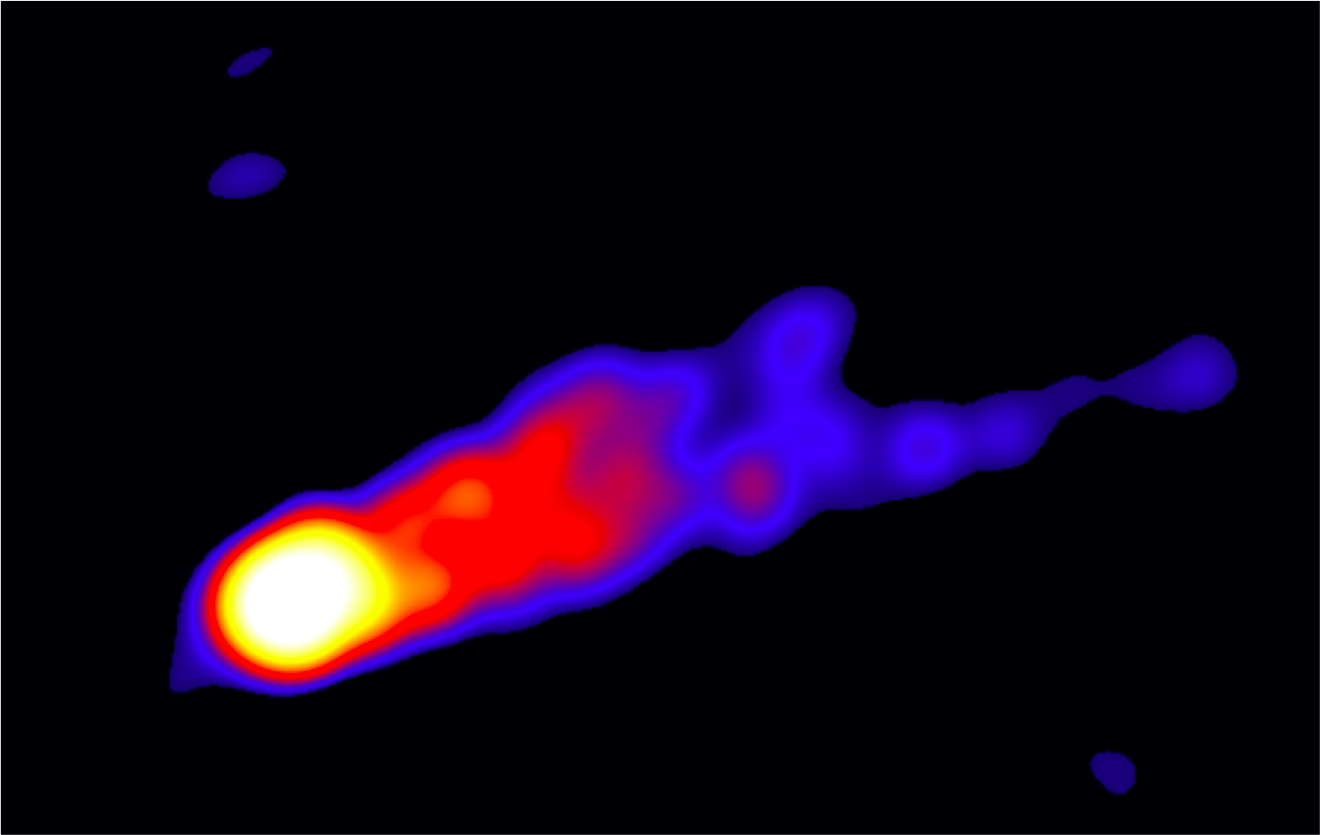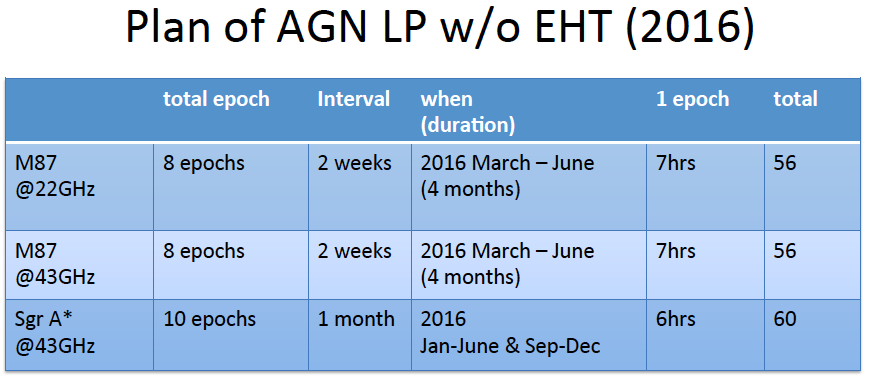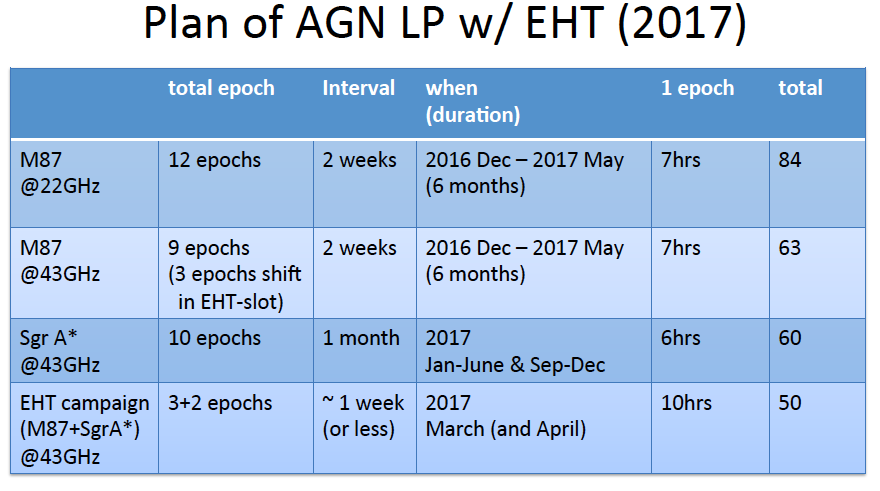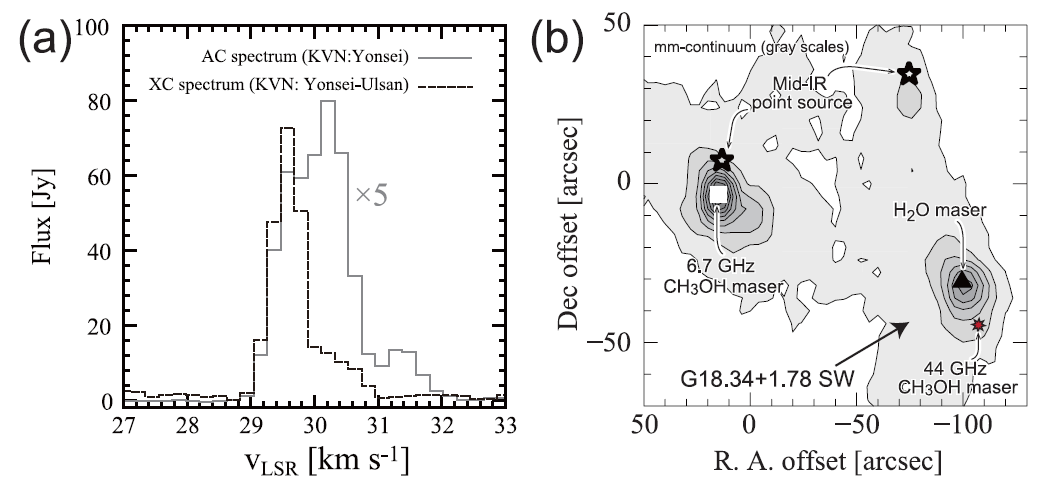Scientific Highlights
- First fringe between KVN and VERA array
- The first VLBI image of Class-I 44 GHz methanol maser with KaVA!
- The initial images of extended AGN jets with KaVA
Large Programs
- ESTEMA (Expanded Study on Stellar Masers)
- Exploring the vicinity of super-massive black hole with KaVA: Intensive monitoring of M87 and Sgr A*
- Understanding high-mass star formation through KaVA observations of water and methanol masers
First fringe between KVN and VERA array
-
The first test observation has been made between KVN Yonsei station in Seoul and VERA Mizusawa station on 1 November 2008, and fringes have been successfully detected at 22 GHz.

fringe of NRAO150 at 22GHz on 1 Nov. 2008. 
-
We have successfully obtained fringes between KVN and VERA full array. On 16 October 2009, the fringe test observation data of 22GHz were recorded on magnetic tape with DIR-1000 recording system, and correlated with FX-correlator at Mitaka.


fringes of NRAO150 at 22GHz on 16 Oct. 2009 2-D map of NRAO150 -
On 27 January 2011, we also have successfully obtained fringes between KVN and VERA full array with Daejeon-correlator at KJCC(Korea-Japan Correlation Center). KVN observation data were recorded on hard disk with Mark5b, and VERA data were recorded on magnetic tape with DIR-2000.
These successful fringe detections make it possible to confirm good performance of the sensitivity and imaging capability of KaVA.

The first VLBI image of Class-I 44 GHz methanol maser with KaVA!

This is the first KaVA imaging result, and the first case in the world to image the Class-I methanol maser with VLBI technique.
The KaVA team observed Class-I 44 GHz methanol (CH3OH) maser around a massive star-forming region of IRAS 18151−1208 MM2 with KaVA array on 2012 April 8th.
This source is one of the brightest 44 GHz methanol masers, which was newly detected in KVN single-dish surveys.
From this result, we found that the Class-I 44 GHz methanol masers have compact components with the size of a few tens of AU. Further observations of the 44 GHz methanol masers would be able to provide three-dimensional velocity maps, and useful informations to reveal the maser pumping mechanisms.
Notes:
- KaVA: KVN and VERA Array
- KVN : Korean VLBI Network
- VERA : VLBI Exploration of Radio Astrometry
- VLBI : Very Long Baseline Interferometry
- maser : Microwave Amplification by Stimulated Emission of Radiation
- mas : milliarcseconds
- vLSR : LSR velocity
- Methanol masers are classified to Class I and II from the properties.
Information of the original paper:
Naoko Matsumoto, Tomoya Hirota, Koichiro Sugiyama, Kee-Tae Kim, Mikyoung Kim, Do-Young Byun, Taehyun Jung et al., “The First Very Long Baseline Interferometry Image of a 44 GHz methanol Maser with the KVN and VERA Array (KaVA)”, ApJL, 2014 July 1st
Go to the topThe initial images of extended AGN jets with KaVA
This is the initial result of extended jet structure of AGNs using new VLBI network “KaVA”, which consists of KVN and VERA. Generally, to obtain a high-quality radio image of an astronomical object, it is necessary to organize as many radio telescopes as possible in VLBI observation. The KaVA team observed three well-known bright AGNs with this new VLBI array.


Fig. 1: Intensity maps of bright AGN 3C 273 observed by VERA (left) and KaVA (right).
By this observation, we confirmed that KaVA observation is able to reproduce the complex structures of AGN jet very well (Fig. 1). This result shows the very high imaging capability of KaVA compared with that of VLBA#1, which is the one of the most powerful VLBI array in the world. We expect that KaVA is very promising VLBI array to investigate the physical mechanism of the jet formation in AGN.
#1: http://www.physics.purdue.edu/astro/MOJAVE/sourcepages/1226+023.shtml
Notes:
- AGN : Active Galactic Nucleus
- VLBA : Very Long Baseline Array
Information of the original paper:
Kotaro Niinuma, Sang-Sung Lee, Motoki Kino, Bong Won Sohn, Kazunori Akiyama, Guang-Yao Zhao, Satoko Sawada-Satoh, et al., “VLBI Observations of bright AGN jets with KVN and VERA Array (KaVA): Evaluation of Imaging Capability”
Go to the topESTEMA (Expanded Study on Stellar Masers)
M. Kino (motoki.kino@nao.ac.jp, NAOJ/Kogakuin Univ.), B.W. Sohn (bwsohn@kasi.re.kr, KASI) on behalf of KaVA AGN Science Working Group*
Proposal ID: EAVN19A-06, EAVN19B-114, EAVN19B-115
Abstract
Exploring the vicinity of super-massive black holes (SMBHs) is one of the frontiers in astrophysics.
Because of the largeness of angular-sizes of the central SMBHs, Sgr A* is the excellent laboratory for studying gas accretion process onto SMBH and M87 is well known as the best case for investigating plasma outflow ultimately driven by SMBH.
To get better understanding of plasma inflow/outflow physics near SMBHs, here we propose the monitoring programs of Sgr A* and M87.
This program is composed of following three sub-programs, i.e., (i) mapping the jet velocity field in M87 and constraining magnetically-driven-jet paradigm, and (ii) probing the nature accreting plasma onto SMBH by monitoring Sgr A*, and (iii) conducting quasi-simultaneous coherent observations of M87 and Sgr A* with the Event Horizon Telescope (EHT) during its campaign observation periods.
(i) Mapping the jet velocity field (M87)
Understanding the formation mechanism of relativistic jets in active galactic nuclei (AGNs) is one of the holy grails in astrophysics. According to the current leading scenario, AGN jets are driven by magnetic (B) force, and subsequently accelerated through the progressive conversion of the magnetic energy into the kinetic one.
Relativistic MHD models have indicated a slow conversion of magnetic energy into kinetic one in relativistic jets. The nearby radio galaxy M87 is known as the best target to test this scenario because of its proximity and the largeness black hole. One of the goals of this proposal is mapping the velocity field of the M87 jet for testing “B-driven jet” paradigm.
Although mapping the velocity field of M87 has been intensively explored in previous work, the apparent velocities in literatures are significantly different and it looks controversial. In order to get robust measurement of possible super-luminal motion, sufficiently short interval (~2 weeks) is needed.
Our goal is mapping the velocity field of the M87 jet that can give unique constraints on theoretical models of B-field driven jet. From the end of Feb 2016, we have started the dual frequency (i.e., 22 and 43 GHz) monitoring of M87 aiming for quasi-simultaneous detections of same components both at 22 and 43 GHz, which will guarantee a robust conclusion. In Figure 1, one can see the actual image of M87 with KaVA at 22 GHz.
 |
|
Figure 1. M87 image at 22GHz obtained by KaVA obtained in 2014. http://www.miz.nao.ac.jp/content/pr/pr20160312/c08 |
(ii) Probing the nature of accreting plasma onto SMBH (Sgr A*)
Sagittarius A* (Sgr A*) hosts the SMBH with largest angular size and thus Sgr A* is well known as one of the best laboratories to explore mass accretion process onto SMBHs. The G2 encounter event, in particular, provides us the once-in-a-million chance for probing the nature of accreting plasma onto SMBH at the galactic center. Recently, Kawashima and colleagues predict a possible change of B-field strength in Sgr A* after the G2 encounter (Kawashima et al. in prep). According to their numerical simulation, the evolution of the magnetic fields in accreting plasma in Sgr A* after the G2 encounter depends on the collision angle between the G2 and accreting flow onto the central black hole. The timescale of mass accretion via viscosity can be also estimated as a few years.
Our goal is to conduct the monthly monitoring of Sgr A* at 43 GHz to look for imprints of G2 encounter. The enhancement of magnetic energy predicted by Kawashima et al. directly leads to the increase of synchrotron flux densities detected by KaVA. We will systematically continue to measure the B-field strength during the monitoring with a timescale of several years.
(iii) Coherent observation of M87 and Sgr A* with the EHT
The EHT is a project to assemble a VLBI network of mm wavelength dishes that can resolve general relativistic signatures near a SMBH. The EHT is now resolving the regions with the size less than 10 Rs around the SMBHs of Sgr A* and M87. The central goal of the EHT experiment is to resolve regions of space-time where gravity is dominant and to detect the strong gravitational field signatures in Sgr A* and M87 (http://www.eventhorizontelescope.org).
Our goal is to conduct KaVA observation of Sgr A* and M87 at 43 GHz of simultaneous with the EHT during March-April campaign and maximize our scientific output via synergetic observations.
Actual Observation Plan in 2016 & 2017
For promoting potential collaborations with communities dealing with other frequencies and/or wavelength in the future, here we show the actual observation plan of this Large Program in 2016 and 2017 season. For further details, please contact M. Kino (kino at kasi.re.kr) and B.W. Sohn (bwsohn at kasi.re.kr).


Exploring the vicinity of super-massive black hole with KaVA: Intensive monitoring of M87 and Sgr A*
M. Kino (motoki.kino@nao.ac.jp, NAOJ/Kogakuin Univ.), B.W. Sohn (bwsohn@kasi.re.kr, KASI) on behalf of KaVA AGN Science Working Group*
Proposal ID: EAVN19A-06, EAVN19B-114, EAVN19B-115
Abstract
Exploring the vicinity of super-massive black holes (SMBHs) is one of the frontiers in astrophysics.
Because of the largeness of angular-sizes of the central SMBHs, Sgr A* is the excellent laboratory for studying gas accretion process onto SMBH and M87 is well known as the best case for investigating plasma outflow ultimately driven by SMBH.
To get better understanding of plasma inflow/outflow physics near SMBHs, here we propose the monitoring programs of Sgr A* and M87.
This program is composed of following three sub-programs, i.e., (i) mapping the jet velocity field in M87 and constraining magnetically-driven-jet paradigm, and (ii) probing the nature accreting plasma onto SMBH by monitoring Sgr A*, and (iii) conducting quasi-simultaneous coherent observations of M87 and Sgr A* with the Event Horizon Telescope (EHT) during its campaign observation periods.
(i) Mapping the jet velocity field (M87)
Understanding the formation mechanism of relativistic jets in active galactic nuclei (AGNs) is one of the holy grails in astrophysics. According to the current leading scenario, AGN jets are driven by magnetic (B) force, and subsequently accelerated through the progressive conversion of the magnetic energy into the kinetic one.
Relativistic MHD models have indicated a slow conversion of magnetic energy into kinetic one in relativistic jets. The nearby radio galaxy M87 is known as the best target to test this scenario because of its proximity and the largeness black hole. One of the goals of this proposal is mapping the velocity field of the M87 jet for testing “B-driven jet” paradigm.
Although mapping the velocity field of M87 has been intensively explored in previous work, the apparent velocities in literatures are significantly different and it looks controversial. In order to get robust measurement of possible super-luminal motion, sufficiently short interval (~2 weeks) is needed.
Our goal is mapping the velocity field of the M87 jet that can give unique constraints on theoretical models of B-field driven jet. From the end of Feb 2016, we have started the dual frequency (i.e., 22 and 43 GHz) monitoring of M87 aiming for quasi-simultaneous detections of same components both at 22 and 43 GHz, which will guarantee a robust conclusion. In Figure 1, one can see the actual image of M87 with KaVA at 22 GHz.

Figure 1. M87 image at 22GHz obtained by KaVA obtained in 2014. http://www.miz.nao.ac.jp/content/pr/pr20160312/c08
(ii) Probing the nature of accreting plasma onto SMBH (Sgr A*)
Sagittarius A* (Sgr A*) hosts the SMBH with largest angular size and thus Sgr A* is well known as one of the best laboratories to explore mass accretion process onto SMBHs. The G2 encounter event, in particular, provides us the once-in-a-million chance for probing the nature of accreting plasma onto SMBH at the galactic center. Recently, Kawashima and colleagues predict a possible change of B-field strength in Sgr A* after the G2 encounter (Kawashima et al. in prep). According to their numerical simulation, the evolution of the magnetic fields in accreting plasma in Sgr A* after the G2 encounter depends on the collision angle between the G2 and accreting flow onto the central black hole. The timescale of mass accretion via viscosity can be also estimated as a few years.
Our goal is to conduct the monthly monitoring of Sgr A* at 43 GHz to look for imprints of G2 encounter. The enhancement of magnetic energy predicted by Kawashima et al. directly leads to the increase of synchrotron flux densities detected by KaVA. We will systematically continue to measure the B-field strength during the monitoring with a timescale of several years.
(iii) Coherent observation of M87 and Sgr A* with the EHT
The EHT is a project to assemble a VLBI network of mm wavelength dishes that can resolve general relativistic signatures near a SMBH. The EHT is now resolving the regions with the size less than 10 Rs around the SMBHs of Sgr A* and M87. The central goal of the EHT experiment is to resolve regions of space-time where gravity is dominant and to detect the strong gravitational field signatures in Sgr A* and M87 (http://www.eventhorizontelescope.org).
Our goal is to conduct KaVA observation of Sgr A* and M87 at 43 GHz of simultaneous with the EHT during March-April campaign and maximize our scientific output via synergetic observations.
Actual Observation Plan in 2016 & 2017
For promoting potential collaborations with communities dealing with other frequencies and/or wavelength in the future, here we show the actual observation plan of this Large Program in 2016 and 2017 season. For further details, please contact M. Kino (kino at kasi.re.kr) and B.W. Sohn (bwsohn at kasi.re.kr).


Understanding high-mass star formation through KaVA observations of water and methanol masers
HIROTA, Tomoya (tomoya.hirota@nao.ac.jp), KIM, Kee-Tae (ktkim@kasi.re.kr), BYUN, Do-Young, CHIBUEZE, James, HACHISUKA, Kazuya, KIM, Jeong-Sook, KIM, Jong-Soo, KIM, Mikyoung, LIU, Tie, MATSUMOTO, Naoko, MOTOGI, Kazuhito, OH, Chung Sik, SHINO, Nagisa, SUGIYAMA, Koichiro, SUNADA, Kazuyoshi, WU, Yuanwei, and KaVA Star-Formation Science sub-WG
Proposal ID: EAVN19B-104
Abstract
KaVA Star-Formation Science sub-WG is planning to conduct a systematic observational study of the 22 GHz water (H2O) and 44 GHz class I methanol (CH3OH) masers in high-mass star-forming regions as a four-year KaVA large program. Our sample consists of approximately 100 high-mass young stellar objects (HM-YSOs) in various evolutionary phases, many of which are associated with two or more maser species. The primary science goal is to understand dynami-cal evolution of HM-YSOs and their circumstellar structures by measuring spatial distributions and 3-dimensional velocity fields of multiple maser species. By combining follow-up obser-vations with VERA (distances), JVN/EAVN (6.7 GHz methanol masers), ALMA and JVLA (thermal lines/continuum), and archive data of infrared catalogs, we will provide novel infor-mation on physical properties (density, temperature, size, mass), 3D dynamical structures of disk/jet/out ow/infalling envelope, and relationship between evolutionary phase of HM-YSOs.
1. Introduction
In spite of their importance in evolution of galaxies and interstellar matters, formation processes of high-mass stars have been long-standing issues. Although significant progress in the recent years has suggested disk accretion process, several practical scenarios are still matter of debate (e.g., turbulent core accretion, competitive accretion, and sometimes, merging may occur). Direct observations of detailed circumstellar structures within 103 AU are definitely essential for addressing evolution of individual HM-YSOs and their feedback history that is closely related to overall star-formation process in host protocluster. Furthermore, source-to-source diversities of jet/out ow, disk, and envelope structures, including time-dependent nature, also contain important suggestions on both of initial condition (angular momentum, magnetic field, etc) and evolutionary process in high-mass star formation.
Strong water and methanol masers are known to be associated with HM-YSOs in a wide range of evolu-tionary phases, and hence, have been employed as good probes of VLBI studies of high-mass star-formation. Multiple maser species are complementary with each other for investigating overall 3D structures and dy-namics around host objects by multi-epoch and multi-species VLBI studies. Such well-compiled and time-resolved VLBI dataset is quite unique in ALMA era, providing us quantitative understanding on evolution of HM-YSOs and their circumstellar structures.
2. Science goals
In this project, we plan to carry out a systematic observational study of 22 GHz water and 44 GHz class I methanol masers toward ~100 HM-YSOs by using KaVA. Multi-epoch VLBI observations will provide proper motions of these two maser lines. We will address key issues in high-mass star formation as summarized below.
- 3D velocity field and spatial structure around various HM-YSOs associated with maser features to investigate dynamical structures of jet/out ow/disk systems.
- Short-term variation/recurrence of 3D velocity field in high-velocity jet/out ow systems to reveal their launching and mass accretion processes.
- Statistical relationship between basic properties of central HM-YSOs and their circumstellar structures traced by masers to understand long-term evolution of HM-YSOs.
3. Observing plan
To achieve the above science goals, we will proceed our project along the following 3 steps:
- First year: Simple snap-shot imaging to study dynamical structure of each maser statistically and to compile a target source list for the further observations.
- Second year: Monitoring observations to measure internal proper motions in multiple maser lines.
- Third year and beyond: Absolute proper motion and parallax measurements in phase-referencing mode.
Observing time will be ~200 hours per year but depending on number of detectable target sources and requested monitoring period/interval which will be determined based on the first year results. As follow-up projects, we have been proposing observing time for other telescopes such as VERA, JVN, ALMA, and JVLA, and obtained part of them (e.g. VERA, ALMA cycle 3 filler).
4. Preliminary results
As preparatory studies, we have started imaging test observations of ~10 HM-YSOs associated with the 44 GHz methanol masers. Figure 1 shows the first VLBI detection of the 44 GHz methanol masers (Matsumoto et al. 2014, ApJL, 789, L1), demonstrating the unique capability of KaVA providing relatively short and dense uv coverage. This is also the first refereed journal paper reporting the KaVA scientific observational results.

Figure 1: An example of 44 GHz methanol maser observations of G18.34-1.78 SW with KaVA (Matsumotoet al. 2014 and references therein). (a) Spectra of the 44 GHz methanol maser. (b) Position of the 44 GHz methanol maser (red symbol) superposed on a 1.2 mm continuum map obtained with the MAMBO array on IRAM 30 m telescope. We will study this kind of M-SFRs hosting different evolutionary phase and/or mass of HM-YSOs by using multiple masers.
Go to the top menu